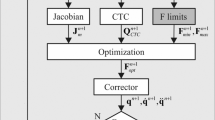Abstract
Described in this paper is a six-legged Stewart-Gough parallel platform driven by a relatively new type of fluidic muscles. The advantage of the platform is that it is virtually free of stick-slip effects. Thus, the device is well-suited for fine-tuned force control and for physical simulation of virtual force-displacement laws. The legs of the platform are of type RRPS and are equipped with a coaxial coil spring and a fluidic muscle providing push and pull forces. Each leg is equipped with a force sensor, a pressure sensor, and a magnetostrictive position encoder. The control for the platform consists of six control loops for the six operated actuators with model-based force control comprising individual gas models as well as the rubber nonlinearities for each leg. The control law also includes the gas flow in the proportional directional control valve in 3/3-way function. The present paper describes the basic architecture of the platform, the dynamic models, as well as testbed results for the existing fluidic-muscle parallel platform DynaHex. It is shown that the presented control scheme leads to a stable force control of the platform for quasi-static motion. As an application, the device will be employed in fields of biomechanics, as well as in general environments requiring physical simulation.
Similar content being viewed by others
References
Merlet J-P (2000) Parallel robots. Kluwer Academic, Norwell
Davliakos I, Papadopoulos E (2008) Model-based control of a 6-dof electrohydraulic Stewart-Gough platform. Mech Mach Theory 43(11):1385–1400
Whitcomb LL, Arimoto S, Naniwa T, Ozaki F (1997) Adaptive model-based hybrid control of geometrically constrained robot arms. IEEE Trans Robot Autom 13(1):105–116
Lopes A, Almeida F (2008) A force-impedance controlled industrial robot using an active robotic auxiliary device. Robot Comput-Integr Manuf 24:299–309
KUKA Roboter GmbH. Robot sensor interface (RSI) release 2.0. KUKA Roboter GmbH, 2001
Liem K, Kecskeméthy A, Merlet J-P (2007) Hexaspine: a parallel platform for physical cervical spine simulation — design and interval-based verification. In: Proceedings of the 12th world congress in mechanism and machine science, June 18–21 2007, Besançon, France
Zhu X, Tao G, Yao B, Cao J (2008) Adaptive robust posture control of a parallel manipulator driven by pneumatic muscles. Automatica 44(9):2248–2257
Carricato M, Parenti-Castelli V (2002) Singularity-free fully-isotropic translational parallel mechanisms. Int J Robot Res 2(21):161–174
Yoshikawa T (1985) Manipulability of robotic mechanisms. Int J Robot Res 4(2):3–9
Ranjbaran F, Angeles J, Kecskeméthy A (1996) On the kinematic conditioning of robotic manipulators. In: IEEE international conference on robotics and automation, vol 4, pp 3167–3172 April 22–28 1996, Minneapolis
Pernkopf F, Husty ML (2004) Workspace classification of Stewart-Gough manipulators with planar base and platform. In: On advances in robot kinematics, pp 229–236
Festo AG & Co. KG. Fluidic muscle MAS, powerful, dynamic, stick-slip-free. Festo AG & Co. KG., 2001
Merlet J-P Determination of 6D-workspace of Gough-type of parallel manipulator and comparison between different geometries. Technical report, INRIA, Sophia-Antipolis, France, 1999
Kecskeméthy A MOBILE user’s guide. Lehrstuhl für Mechanik und Robotik, Universität Duisburg-Essen, 2003
Merlet J-P A C++ algorithms library of interval analysis for equation systems, version 2.3. Technical report, INRIA, Sophia-Antipolis, France, September 2004
Dhanu-Singh M, Liem K, Kecskeméthy A, Neumann R (2005) Design and control of a pneumatic hybrid actuator. In: Proceedings of the 76th annual scientific conference of GAMM, March 28–April 1 2005, Luxembourg, pp 497–498
Dhanu-Singh M, Liem K, Neumann R, Kecskeméthy A (2007) Force control of a fluidic-muscle driven parallel platform. In: Proceedings of the 6th international congress on industrial and applied mathematics (ICIAM), July 16–20, 2007, Zurich, Switzerland
Wey T (2002) Nichtlineare Regelungssysteme. Teubner, Leipzig
Langer M Flachheitsbasierte Regelung eines Fluidic-Muscles basierend auf experimentellen Kennfeldern. Diploma thesis, Universität Duisburg-Essen, 2007
Author information
Authors and Affiliations
Corresponding author
Rights and permissions
About this article
Cite this article
Dhanu Singh, M., Liem, K., Leontjievs, V. et al. A fluidic-muscle driven force-controlled parallel platform for physical simulation of virtual spatial force-displacement laws. Meccanica 46, 171–182 (2011). https://doi.org/10.1007/s11012-010-9407-8
Received:
Accepted:
Published:
Issue Date:
DOI: https://doi.org/10.1007/s11012-010-9407-8




